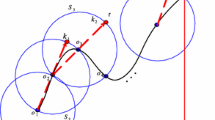Abstract
The continuation methods are efficient methods to trace solution curves of nonlinear systems with parameters, which are common in many fields of science and engineering. Existing continuation methods are unstable for some complicated cases in practice, such as the case that solution curves are close to each other or the case that the curve turns acutely at some points. In this paper, a more robust corrector strategy—sphere corrector is presented. Using this new strategy, combining various predictor strategies and various iterative methods with local quadratic or superlinear convergence rates, robust continuation procedures for tracing curves are given. When the predictor steplength is no more than the so-called granularity of solution curves, our procedure of tracing solution curve can avoid “curve-jumping” and trace the whole solution curve successfully. Numerical experiments illustrate our method is more robust and efficient than the existing continuation methods.
Similar content being viewed by others
References
Alexander, J.C.: Numerical continuation methods and bifurcation. In: Functional Differential Equations and Approximation of Fixed Points. Proc. Summer School and Conf., Univ. Bonn, Bonn, 1978. Lecture Notes in Math, vol. 730, pp. 1–15. Springer, Berlin (1979)
Allgower, E.L., Georg, K.: Estimates for piecewise linear approximations of implicitly defined manifolds. Appl. Math. Lett. 2(2), 111–115 (1989). doi:10.1016/0893-9659(89)8990001-3
Allgower, E.L., Georg, K.: Numerical Continuation Methods, Springer Series in Computational Mathematics, vol. 13. Springer, Berlin (1990). An introduction
Allgower, E.L., Georg, K.: Introduction to numerical continuation methods. Classics in Applied Mathematics, vol. 45. Society for Industrial and Applied Mathematics (SIAM), Philadelphia (2003). Reprint of the 1990 edition [Springer-Verlag, Berlin; MR1059455 (92a:65165)]
Bonnans, J.F., Gilbert, J.C., Lemaréchal, C., Sagastizábal, C.A.: Numerical Optimization Universitext, 2nd edn. Springer, Berlin (2006). Theoretical and practical aspects
Elhage-Hussein, A., Potier-Ferry, M., Damil, N.: A numerical continuation method based on Padé approximants. Int. J. Solids Struct. 37(46–47), 6981–7001 (2000). doi:10.1016/S0020-7683(99)00323-6. Stability, strength and stiffness in materials and structures
Georg, K.: On tracing an implicitly defined curve by quasi-newton steps and calculating bifurcation by local perturbations. SIAM J. Sci. Statist. Comput. 2(1), 35–50 (1981). doi:10.1137/0902004
Gervais, J.J., Sadiky, H.: A new steplength control for continuation with the asymptotic numerical method. IMA J. Numer. Anal. 22(2), 207–229 (2002). doi:10.1093/imanum/22.2.207
Gervais, J.J., Sadiky, H.: A continuation method based on a high order predictor and an adaptive steplength control. ZAMM Z. Angew. Math. Mech 84(8), 551–563 (2004). doi:10.1002/zamm.200310125
Huber, B., Verschelde, J.: Polyhedral end games for polynomial continuation. Numer. Algoritm. 18(1), 91–108 (1998). doi:10.1023/A:1019163811284
Krauskopf, B., Osinga, H.M., Galán-Vioque, J., (eds.): Numerical Continuation Methods for Dynamical Systems. Understanding Complex Systems. Springer, Dordrecht (2007). doi:10.1007/978-1-4020-6356-5. Path following and boundary value problems, Dedicated to Eusebius J. Doedel for his 60th birthday
Lahmam, H., Cadou, J.M., Zahrouni, H., Damil, N., Potier-Ferry, M.: High-order predictorccorrector algorithms. Int. J. Numer. Methods Eng. 55(6), 685–704 (2002). doi:10.1002/nme.524
Lan, G., Monteiro, R.D.C., Tsuchiya, T.: A polynomial predictor-corrector trust-region algorithm for linear programming. SIAM J. Optim. 19(4), 1918–1946 (2008). doi:10.1137/070693461
Leykin, A., Verschelde, J., Zhao, A.: Newton’s method with deflation for isolated singularities of polynomial systems. Theor. Comput. Sci. 359(1–3), 111–122 (2006). doi:10.1016/j.tcs.2006.02.018. http://www.sciencedirect.com/science/article/pii/S030439750600168X
Lundberg, B.N., Poore, A.B.: Variable order Adams-Bashforth predictors with an error-stepsize control for continuation methods. SIAM J. Sci. Statist. Comput. 12(3), 695–723 (1991). doi:10.1137/0912037
Mackens, W.: Numerical differentiation of implicitly defined space curves. Computing 41(3), 237–260 (1989). doi:10.1007/BF02259095
Morgan, A., Sommese, A., Wampler, C.: A power series method for computing singular solutions to nonlinear analytic systems. Numer. Math. 63(1), 391–409 (1992). doi:10.1007/BF01385867
Nocedal, J., Wright, S.J.: Numerical Optimization. Springer Series in Operations Research and Financial Engineering, 2nd edn. Springer, New York (2006)
Ojika, T.: Modified deflation algorithm for the solution of singular problems. i. a system of nonlinear algebraic equations. J. Math. Anal. Appl. 123(1), 199–221 (1987). doi:10.1016/0022-247X(87)90304-0. http://www.sciencedirect.com/science/article/pii/0022247X87903040
Rheinboldt, W.C.: Numerical continuation methods for finite element applications, Formulations and Computational Algorithms in Finite Element Analysis (U.S.-Germany Sympos., Mass. Inst. Tech., Cambridge, Mass., 1976), pp 599–631. MIT Press, Cambridge (1977)
Salahi, M., Peng, J., Terlaky, T.: On Mehrotra-type predictor-corrector algorithms. SIAM J. Optim. 18(4), 1377–1397 (2007). doi:10.1137/050628787
Salahi, M., Terlaky, T.: Mehrotra-type predictor-corrector algorithm revisited. Optim. Methods Softw. 23(2), 259–273 (2008). doi:10.1080/10556780701661393
Schwetlick, H., Cleve, J.: Higher order predictors and adaptive steplength control in path following algorithms. SIAM J. Numer. Anal. 24(6), 1382–1393 (1987). doi:10.1137/0724089
Sim, C.K.: Superlinear convergence of an infeasible predictor-corrector path-following interior point algorithm for a semidefinite linear complementarity problem using the Helmberg-Kojima-Monteiro direction. SIAM J. Optim. 21(1), 102–126 (2011). doi:10.1137/090779279
Author information
Authors and Affiliations
Corresponding author
Additional information
Bo Dong’s research was supported in part by the National Natural Science Foundation of China (Grant No. 11101067), TianYuan Special Funds of the National Natural Science Foundation of China (Grant No. 11026164) and the Fundamental Research Funds for the Central Universities.
Bo Yu’s research was supported in part by the Major Research Plan of the National Natural Science Foundation of China(No.91230103), the National Nature Science Foundation of China (Grant No. 11171051) and the Fundamental Research Funds for the Central Universities.
Rights and permissions
About this article
Cite this article
Yu, Y., Yu, B. & Dong, B. Robust continuation methods for tracing solution curves of parameterized systems. Numer Algor 65, 825–841 (2014). https://doi.org/10.1007/s11075-013-9716-9
Received:
Accepted:
Published:
Issue Date:
DOI: https://doi.org/10.1007/s11075-013-9716-9




